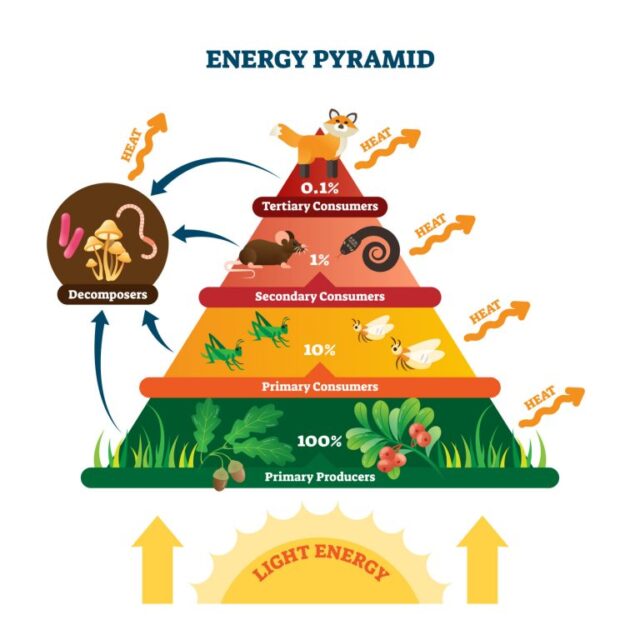The three-to five level energy pyramid is a widely used model in the food industry. However, some studies have shown that the energy levels of foods can be much higher than previously thought. This article explores why most pyramids are limited to three to five levels and what this means for consumers.
The why are populations of top carnivores smaller than herbivores is a question that has been asked for years. Scientists have found that the reason why most energy pyramids are limited to three to five levels, is because the more energy an organism consumes, the more likely it will be possible for it to survive.
Why are energy pyramids in ecosystems usually restricted to just four or five levels? because the amount of energy available decreases as trophic levels rise. Because there would be no energy left for species higher in the trophic levels, the pyramid is restricted to four or five levels.
Why are energy pyramids restricted to 3/5 levels in this regard?
Explanation: Energy is lost mainly via heat loss and respiration at each trophic level. As a result, the primary producer provides relatively little energy to the predator (animal at the top of the pyramid). As a result, it is much more difficult for creatures further up the pyramid to get the nutrients they need.
Why does an energy pyramid have a maximum number of trophic levels? Energy is transferred up a food chain or web from lower trophic levels to higher trophic ones. However, only approximately 10% of the energy accessible at one level is available in the next. This energy loss explains why a food chain or web seldom has more than four trophic levels.
Which pyramid level contains the greatest energy?
Producers (organisms that generate their own food) are found at the lowest trophic level in all ecological pyramids. The greatest quantity of energy is found at this trophic level. Each trophic level of an energy pyramid has just 10% of the energy of the level below it.
Why is it that food chains can only have a maximum of five levels?
Because energy losses between trophic levels limit the length of food chains and the biomass of higher trophic levels, food chains are restricted to 4-5 trophic levels. Usually, species at the next trophic level do not devour all of the organisms in the previous trophic level.
Answers to Related Questions
What exactly is the 10% rule?
When energy is transferred from one trophic level to the next in an ecosystem, the 10% Rule states that only ten percent of the energy is passed on. A trophic level refers to an organism’s location in a food chain or energy pyramid.
What is the lowest energy level in the food chain?
As a result, herbivores and detritivores (secondary consumers) and carnivores who eat other carnivores (tertiary consumers) have the least amount of energy available to them.
Where does 90 percent of the energy go?
The majority of this energy is needed to keep the plant alive. The remainder of the energy is transferred to the next level of the food chain as food. The diagram on the left depicts the movement of energy in a basic food chain. It’s worth noting that approximately 90% of the energy is wasted as heat at each rung of the food chain.
What is a number pyramid?
A graphical depiction of the number of creatures at each trophic level is called a pyramid of numbers. Charles Elton proposed the pyramid of numbers in 1927. The number of creatures engaged in each rung of the food chain varies dramatically, as Charles pointed out.
Why do trophic levels have a limit?
Because each trophic level consumes a significant amount of energy for organism maintenance and loses it as heat, the number of trophic levels in the food chain is restricted. At each trophic level, the energy level decreases, and only 10% of the energy is passed on to the next level.
What does it mean to have trophic levels?
Definition of Trophic Level. A trophic level is a collection of species in an environment that share the same food chain level. Herbivores, also known as primary consumers, are the second trophic level. They obtain energy by consuming primary producers.
Why is it so uncommon to find a fifth trophic level?
From lower to higher trophic levels, energy is transferred up a food chain or web. This energy loss explains why a food chain or web seldom has more than four trophic levels. There may be a fifth trophic level, but there is typically insufficient energy to sustain any further levels.
In a food pyramid, where is the least amount of energy?
Explanation: Energy pyramids are graphs that depict ecological energy flow. At the bottom of the pyramid, there is the most energy, and at the top, there is the least. The producers are at the bottom of the pyramid, obtaining energy from the sun via photosynthesis.
Which level has the greatest amount of energy?
Explanation and Answer:
The trophic level representing producers (plants) has the greatest energy since the sun is the source of energy.
What are the meanings of energy pyramids?
A biomass pyramid indicates how much biomass (the quantity of living or organic matter contained in an organism) is present in the organisms, while an energy pyramid shows how much energy is maintained in the form of new biomass at each trophic level.
What is the most energetic component of the food chain?
The greatest energy is found in the first trophic level of the food chain. The producers, which are all photosynthetic creatures, are found at this level.
What exactly is a pyramid?
A pyramid is a polyhedron with a base (which may be any shape) and three or more triangle faces that meet at the apex. To differentiate them from the base, these triangular sides are also referred to as the lateral faces.
What are some examples of trophic levels?
In a food chain, the trophic level is the functional level inhabited by an organism. Producers or autotrophs, for example, occupy the first trophic level, which fix solar energy and make food. ‘Herbivores’ make up the second trophic level.
What is the best way to locate the energy pyramid?
Determine what percentage of energy is transported from the first to the second trophic level. Multiply the energy from trophic level one by 100. This is the percentage of energy that has been transmitted.
What trophic level do people belong to?
Many people are omnivores, which means they eat both plant and animal matter. As a result, they may be on the third or fourth trophic level. If you eat beef (cows are herbivores), for example, you are in the third trophic level.
Why is only 10% of energy transmitted from one trophic level to the next?
As an ecosystem progresses, the quantity of energy at each trophic level decreases. Only about 10% of the energy at each trophic level is transferred to the next; the remainder is wasted mostly as heat via metabolic processes.
How can you figure out what trophic levels are?
The trophic level of an organism is described as its place in the food chain, and it spans from 1 for primary producers to 5 for marine animals and humans. The trophic level of a consumer is calculated by adding one level to the mean trophic level of its prey.
What factors contribute to the number of trophic levels being limited?
Bottom up restriction occurs when the supply of food (algae, detritus, or prey) at one trophic level is restricted by the availability of food (algae, detritus, or prey) at a lower trophic level. Top down restriction arises when the actions of the trophic level above it (grazing, predation) limit a specific trophic level.
The trophic levels and ecological pyramids worksheet answers is a question that asks why are most energy pyramids limited to three to five levels. In this article, it will be explained what the trophic levels are and how they work with ecological pyramids.
Frequently Asked Questions
Can an energy pyramid have 3 levels?
Yes, an energy pyramid can have 3 levels.
Why are there so few levels on the energy pyramid?
There are only 10 levels on the energy pyramid because it is a tutorial.
Why are there maximum 5 trophic levels?
The maximum number of trophic levels is due to the amount of time it takes for a player to complete a level. If you were to increase this, it would take longer for the user to complete and more likely result in them quitting out of frustration.
Related Tags
- ecological pyramids pogil
- other species that might be found in the trophic level with the blue jays.
- the present rate of species loss ______.
- with regard to nutrient pollution in aquatic ecosystems
- list at least three other species that might be found in the trophic level with the oak trees.




